After three hours plus of bus-time, we negotiated the last leg of out trip over a very dusty road marked "Drive Slow", which we were assured represented a vast improvement over the previous unimproved gravel road. At least now we have pavement.
We arrived at the Punta Tombo Penguin Rookery just after noon and we were told to be back on the bus by ten to one. We were a little miffed to have our penguin encounter cut so short, having paid muchos dólares to come, but what can you do? The ship sails when it sails, and we still have to drive three hours back.
We walked up a hill covered with the same kind of scrub that we'd been looking at all along, but all of a sudden I noticed that most of the bushes have holes or scrapes dug under them, and every hole contains penguins!

These are Magellanic Penguins, one of the smaller sorts (around 18" tall) with a lot of bold black-and-white striping on their heads and around their bellies and a pink circle around their red, beady eyes.
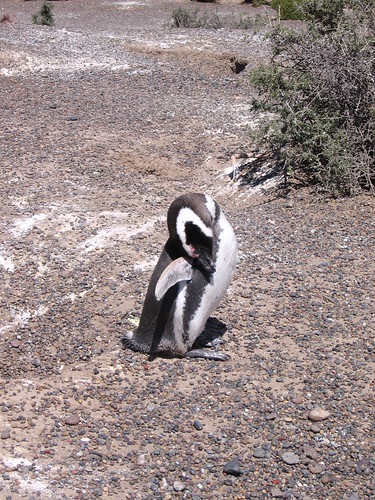
The penguins in or near the holes are usually preoccupied with tending a pair of chicks:

There's no telling if this is the mom or the dad; the two sexes take equal turns in child raising. The chicks hatched about a month ago, and from then on the parents are on an endless rotating shift: one stays with the babies and the other goes in the ocean after fish, then comes back and feeds them to the chicks (regurgitates, actually - yick!). Then they switch shifts and the other parent goes fishing. This is why tourists are restricted to the path between some white stones (visible in the upper left, below)
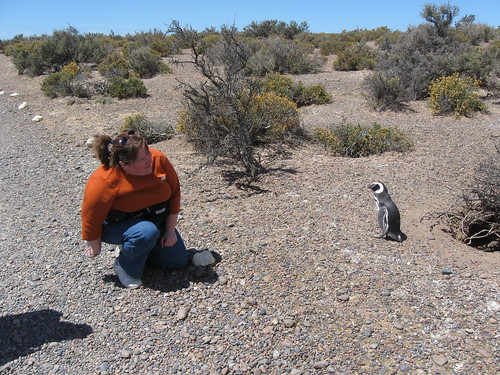
while the penguins have the right of way. They go back and forth to the ocean a lot!
We learned a number of interesting penguin-raising facts from our guide on the drive down.
- Magellanic penguins mate for life, but it's really more like they buy a house for life and the mate just comes along with. At the age of five, they choose a nest site that's within 100 yards or so of the nest they were born in, and they come back to that same nest - and the same mate - for the next fifteen years.
- If the parents die before the eggs hatch, another penguin will adopt the eggs. However, if the chicks have already hatched they are not adopted.
- During chick-raising season the parents don't eat for themselves at all. They just feed the babies until the babies molt at age 6-8 months. They grow adult feathers (solid black and white, with no stripes) which lets them swim, and they're on their own.
- Next, the parents molt (Analise says they are so thin by then you can see their wishbones) and when they finally grow their feathers back they go to sea and eat for three months straight. The males come ashore then (in September) and get the nests ready, while the females keep eating until October, when they come to land, mate and lay their two eggs.
- You'll note that one chick is a lot larger than the other. That one hatched first and has a head start from there on; the other one is a backup chick and sooner or later it'll get crowded out of being fed at all. Only if Big Chick meets with an accident - like getting eaten by a gull or a skua
- does Little Chick get to grow up. Nature red in tooth and claw, I guess.
- Adolescents between the ages of one and five come back home and hang around their parents' nest while they molt. Annalise said in February the beaches are just crammed with penguins: parents, chicks, adolescents molting - like half a million individuals. Even though there aren't that many here yet, there are still plenty!
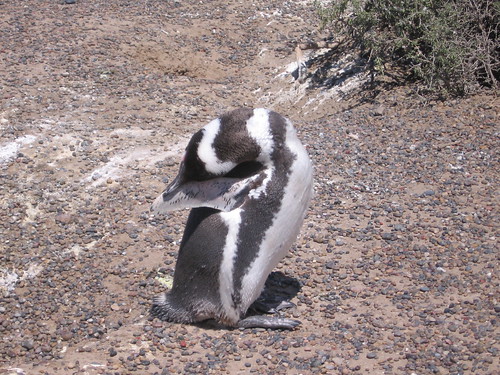
bask,

stand around,
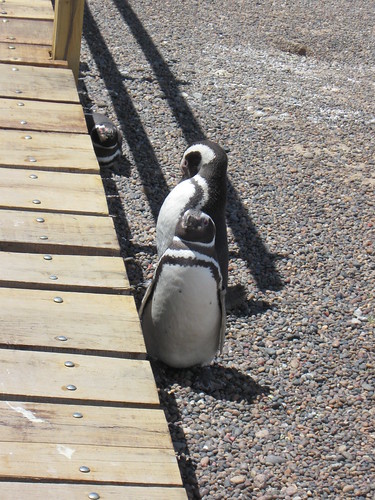
and practice adult behaviors:
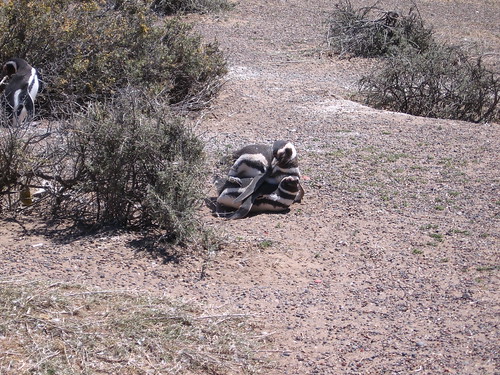
(It's the wrong season for real mating; these two are just fooling around.)
Those wooden bridge-looking things above are elevated walkways the parks service has built for the tourists, that the penguins just scoot right under. They're a favorite hangout for the unattached, who are extremely curious and like to investigate these odd creatures who keep pointing shiny glass objects toward them. One of them got almost close enough for me to touch:
Warning: If you are at all susceptible to motion sickness you may want to skip the rest of the videos. I'm not exactly a steadicam operator.
Preening Penguin
Cheeping Chicks
I'm Following You
Fall Down Go Boom


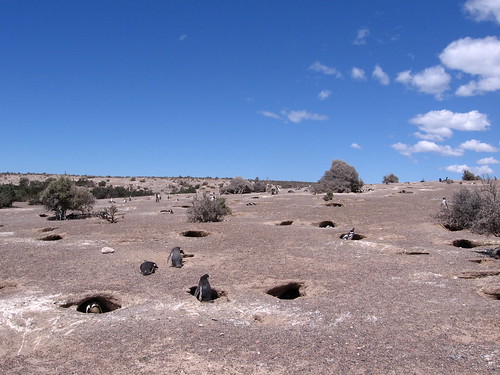
No comments:
Post a Comment